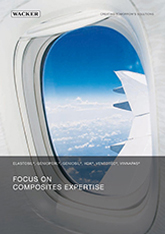Composite Molding

Häufig wiederverwendbar: Die Hauben (ca. 4 x 3 m) lassen sich zum Transport aufrollen und viele Male wiederverwenden. Die abgebildete Haube ist bereits mehr als 250 Mal verwendet worden.
Für Infusions- und Prepreg-Verfahren liefert WACKER neben Siliconharzadditiven auch Siliconkautschuk und Gewebe für die Herstellung von Vakuumhauben. Diese Hauben können in jedem Produktionszyklus schnell und prozesssicher auf die Form gelegt werden. Das wiederholte zeitintensive Versiegeln mit Vakuumfolie entfällt. Hauben aus schnell vulkanisierendem, zweikomponentigem ELASTOSIL® Siliconkautschuk sorgen für eine höhere Produktionsrate, einen geringeren Dampfaustritt und mehr Flexibilität.

Vorteile der Vakuumhauben-Technologie
- Kürzere Produktionszyklen
- Geringere Ausgasung
- Weniger Abfall
- Geringerer Arbeitsaufwand
Vorteile von ELASTOSIL®:
- Flexibel
- Selbstnivellierend
- Längere Verarbeitungs- und Vukanisationszeiten
- Geeignet für große Flächen
- Geeignet für vertikale Flächen
- Wiederverwendbar
Silicone kommen zudem bei der Herstellung von Stößein oder Bälgen zum Einsatz, die genutzt werden, um während des Composite-Prozesses den Druck auf das Composite zu erhöhen. In diesem Anwendungsbereich kommt es besonders auf die Wiederverwendbarkeit und die Ablöseeigenschaften sowie eine gute Chemikalienbeständigkeit an.




